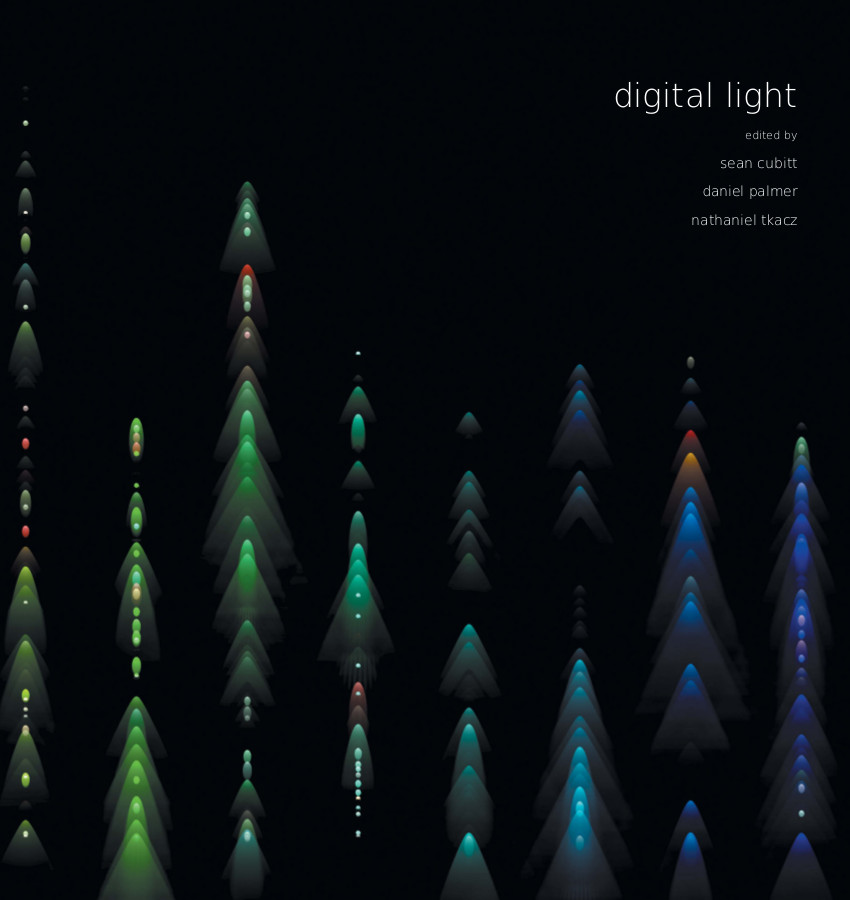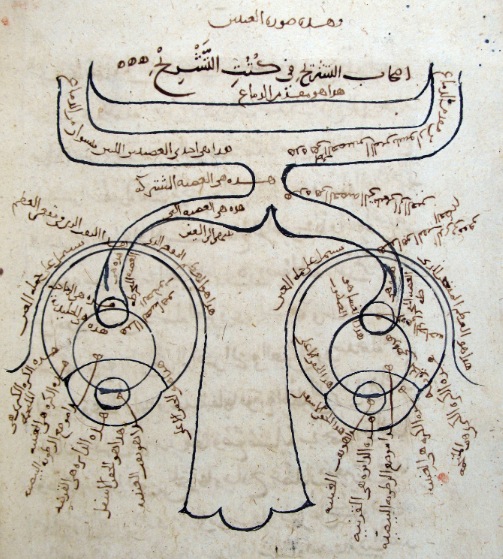Sean Cubitt, Daniel Palmer, Nathaniel Tkacz (eds.): Digital Light (2015)
Filed under book | Tags: · aesthetics, art, cinema, digital, film, image, light, optics, photography, screen, technology, vision

“Light symbolises the highest good, it enables all visual art, and today it lies at the heart of billion-dollar industries. The control of light forms the foundation of contemporary vision. Digital Light brings together artists, curators, technologists and media archaeologists to study the historical evolution of digital light-based technologies. Digital Light provides a critical account of the capacities and limitations of contemporary digital light-based technologies and techniques by tracing their genealogies and comparing them with their predecessor media. As digital light remediates multiple historical forms (photography, print, film, video, projection, paint), the collection draws from all of these histories, connecting them to the digital present and placing them in dialogue with one another.
Light is at once universal and deeply historical. The invention of mechanical media (including photography and cinematography) allied with changing print technologies (half-tone, lithography) helped structure the emerging electronic media of television and video, which in turn shaped the bitmap processing and raster display of digital visual media. Digital light is, as Stephen Jones points out in his contribution, an oxymoron: light is photons, particulate and discrete, and therefore always digital. But photons are also waveforms, subject to manipulation in myriad ways. From Fourier transforms to chip design, colour management to the translation of vector graphics into arithmetic displays, light is constantly disciplined to human purposes. In the form of fibre optics, light is now the infrastructure of all our media; in urban plazas and handheld devices, screens have become ubiquitous, and also standardised. This collection addresses how this occurred, what it means, and how artists, curators and engineers confront and challenge the constraints of increasingly normalised digital visual media.
While various art pieces and other content are considered throughout the collection, the focus is specifically on what such pieces suggest about the intersection of technique and technology. Including accounts by prominent artists and professionals, the collection emphasises the centrality of use and experimentation in the shaping of technological platforms. Indeed, a recurring theme is how techniques of previous media become technologies, inscribed in both digital software and hardware. Contributions include considerations of image-oriented software and file formats; screen technologies; projection and urban screen surfaces; histories of computer graphics, 2D and 3D image editing software, photography and cinematic art; and transformations of light-based art resulting from the distributed architectures of the internet and the logic of the database.”
Publisher Open Humanities Press, London, 2015
Fibreculture Books series
Creative Commons BY-SA 4.0 License
ISBN 1785420089, 9781785420085
224 pages
Review: Mathias Denecke (Culture Machine, 2016).
PDF, PDF, PDF (4 MB, updated on 2016-7-19)
Comment (0)The Optics of Ibn Al-Haytham, Books I–III: On Direct Vision (c1028-38/1989)
Filed under book | Tags: · colour, geometry, light, mathematics, optics, perception, physics, vision

This is the first English translation of first three out of the 7 volumes of the fundamental work on optics by the medieval Arab scientist Ibn al-Haitham or Alhazen (965–c1039). His book exerted a great influence upon science through Witelo, Roger Bacon, Peckham and Kepler. Alhazen investigated many particular cases of reflection and refraction, and drew attention to the light-ray’s property of retracing its path when reversed. He was the first to give a detailed description of the human eye and to study binocular vision. Certain ophthalmological terms originated from the Latin translation of Alhazen’s Arabic text, e.g. retina and cornea.
The Book of Optics (Kitāb al-Manāẓir, كتاب المناظر) presented experimentally founded arguments against the widely held extramission theory of vision (as held by Euclid in his Optica) and in favour of intromission theory, as supported by thinkers such as Aristotle, the now accepted model that vision takes place by light entering the eye.
Part 1 contains the translation; Part 2 an introduction, commentary, Arabic-Latin glossaries, concordance, bibliography, and indices.
Edition of the Arabic text, edited by A. I. Sabra, was published by National Council for Culture, Arts and Letters, Kuwait, in 1983 (Books I-III) and 2002 (Books IV-V). Sabra’s translation of the latter has not yet been published.
Translated with Introduction and Commentary by A. I. Sabra
Publisher The Warburg Institute, University of London, London, 1989
Studies of the Warburg Institute, 40/1-2
ISBN 0854810722, 9780854810727
367 and 246 pages, 4 plates (following p. 42 in Part 2)
Review (Alexander Jones, Isis, 1991)
Review (George Saliba, Speculum, 1992)
Wikipedia
Translator
Publisher (WI)
Publisher (SAS)
PDF (pp xvi-xix of Part 2 missing; 18 MB)
Latin translation:
Liber de aspectiibus et vocatur prospectiva (digital facsimile of Latin translation of all 7 volumes, manuscript, Ms 1393)
Opticae thesaurus (edition of the Latin translation by Friedrich Risner, 1572; Archive.org)
See also the first episode of Simon Schaeffer’s 2004 BBC documentary series Light Fantastic, “Let There Be Light”, where he discusses Alhazen and others.
Comment (0)Jonathan Crary: Techniques of the Observer: On Vision and Modernity in the Nineteenth Century (1990–) [EN, HU, TR, ES, BR-PT, CN]
Filed under book | Tags: · 1800s, art, art history, body, camera obscura, image, knowledge, optics, painting, perception, perspective, representation, science, space, vision

“In Techniques of the Observer Jonathan Crary provides a dramatically new perspective on the visual culture of the nineteenth century, reassessing problems of both visual modernism and social modernity.
Inverting conventional approaches, Crary considers the problem of visuality not through the study of art works and images, but by analyzing the historical construction of the observer. He insists that the problems of vision are inseparable from the operation of social power and examines how, beginning in the 1820s, the observer became the site of new discourses and practices that situated vision within the body as a physiological event. Alongside the sudden appearance of physiological optics, Crary points out, theories and models of “subjective vision” were developed that gave the observer a new autonomy and productivity while simultaneously allowing new forms of control and standardization of vision.
Crary examines a range of diverse work in philosophy, in the empirical sciences, and in the elements of an emerging mass visual culture. He discusses at length the significance of optical apparatuses such as the stereoscope and of precinematic devices, detailing how they were the product of new physiological knowledge. He also shows how these forms of mass culture, usually labeled as “realist,” were in fact based on abstract models of vision, and he suggests that mimetic or perspectival notions of vision and representation were initially abandoned in the first half of the nineteenth century within a variety of powerful institutions and discourses, well before the modernist painting of the 1870s and 1880s.”
Publisher MIT Press, Dec 1990
October Books series
ISBN 0262031698
171 pages
Publisher (EN)
Techniques of the Observer: On Vision and Modernity in the Nineteenth Century (English, 1990, 21 MB, updated on 2015-2-18)
A megfigyelő módszerei. Látás és modernitás a 19. században (Hungarian, trans. Ágnes Lukács, 1999, no OCR)
Gözlemcinin Teknikleri. On Dokuzuncu Yüzyılda Görme ve Modernite (Turkish, trans. Elif Daldeniz, 2002/2004, added on 2024-3-3)
Las técnicas del observador: visión y modernidad en el siglo XIX (Spanish, trans. Fernando López García, 2008)
Técnicas do observador: visão e modernidade no século XIX (BR-Portuguese, trans. Verrah Chamma, 2012, added on 2024-3-3)
Guan cha zhe de ji shu / 观察者的技术 (Chinese, 2017, added on 2024-3-3)

